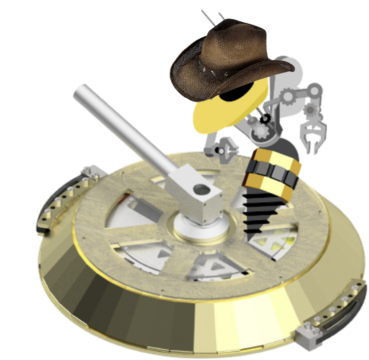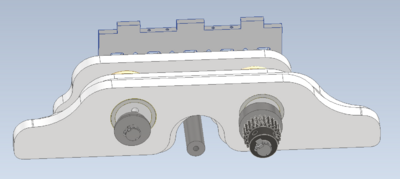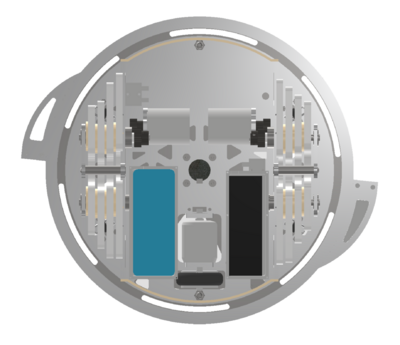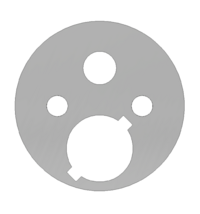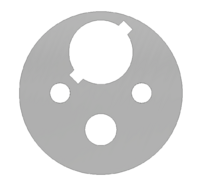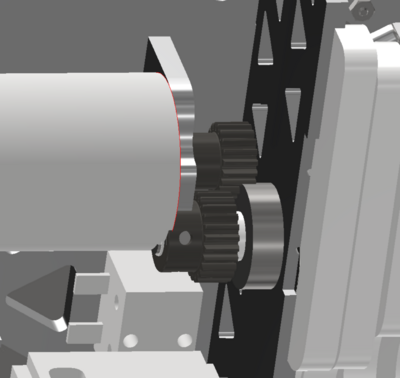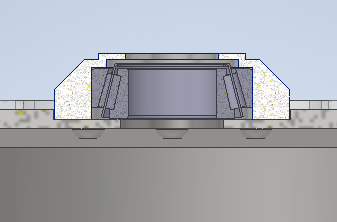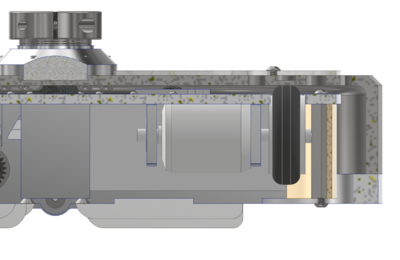Chonkiii
| Chonki | |
|---|---|
| Year Of Creation | 2020-2021 |
| Versions | |
| Current Version | V 2.0 |
| Update Year | 2021-2022 |
| Wins/Losses | 2/2 Moto 1/2 AVC |
| Information and Statistics | |
| Weight Class | Featherweight |
| Weapon Class | Shell Spinner |
| Combined Wins/Losses | 3/4 |
| Weapon Speed | 1200 RPM (67 MPH) |
| Other | Chonk!!! |
Contents
Introduction
This robot had a name before a design. It born when Brian thought to himself, "Hey, it would be really funny if we named a robot Chonki and made it really, really big and really really loud..." Throughout the design process the robot lived up to its name. Chonkii is a 45lb shuffling shell spinner competing in the 30lb weight class that serves as an iteration on the original Chonki, which was never fully constructed. It was developed during 2022-2023. The drive system was iterated from that of Apachi, Chonki, and Chonkii. The friction driven shell was not a challenge that had previously been attempted by BattleBots, outside of the previous Chonki iterations. The goal of Chonkiii was to improve all aspects of Chonkii after the latter had a promising performance at Motorama that was deemed to warrant iteration. Chonkiii competed at NHRL March 2023 and finished with a 2-1 record.
Members:
- Sydney Bakey (Lead
- Mihir Nagaraj (Mentor)
- Brian Epstein (Mentor)
- Janie Edgar
- Jacques
- Cade Tyler
- Dan Vail
- Maddie
- Christopher Bellflowers
- [FINISH ADDING MEMBERS]
Overview
Purpose
Chonkiii is the third iteration of a 45 lb shuffling shell spinner BattleBot. The robot consists of a chassis that remains stationary relative to the ground and a rotating steel shell that surrounds the entire robot. Chonkiii aims to improve on the design of the previous iteration’s shuffling module by improving the components or areas we ran into issues with in competition. The goal is to design and implement a self-righting mechanism, a more durable shell, and superior traction on the feet.
Now that Chonkii has seen competition, much of our design process focused on improving its durability and compatibility in competition. The self-righting bar will extend up and outward from the robot, acting as a lever arm to push against the ground and shove it back up right. The shell will be manufactured with a 50 degree slant to counteract undercutters and encourage more of a glancing hit than a direct one. The shell will also be manufactured out of a harder steel, AR 400, to prevent large dents that will cause the shell to wobble when it spins. More traction is needed to successfully compete with the speeds of the other robots, so the previous method of hot glue will be experimentally tested against new specially applied spikes.
Concept Motivation
Chonki as a concept started as a name and not a design. Brian brought it into existence by thinking "Hey, it would be really funny if we named a robot Chonki and made it really, really big and really really loud..." The more practical goal of Chonki was to utilize the 1.5 times weight bonus from not using wheels for movement to evaluate shell spinners. In its second iteration, Chonkii lived up to its name and goal, attracting many viewers and hearing protection at competition due to the loud noise of the shufflers on steel floors. While Chonkii did manage to achieve many of its goals and function during competition, it had much room for improvement. In its third iteration, Chonkiii’s concept motivation is simplistically to take Chonkii, make it work, and make it work even better.
High Level Design Overview
At its core, Chonki is designed to absorb large hits and win through attrition. Historically, RoboJackets driver have not been particularly skilled. Chonkiii’s full body shell ensures that, when spun up, Chonkiii does not have a clear weak spot. The tapered shell is ¼” thick and weighs 24lbs. To accommodate for the increased weight, Chonkiii uses a shuffling drive system and utilizes a 150% weight bonus.
Chassis System
Overview
The overall frame of the chassis forms a cylinder that fits inside of the rotating shell resting on top of it. The self-right bar extends from the top of the center shaft to enable the bot to re-right itself if it is ever flipped on its top. The HPDE side plates on each side of the bot provide protection for the internal electronics while also not adding much weight. These features can be seen in the image of the chassis below.
<PUT IN PICTURE>
Top Plate
The top plate is made from waterjet 1⁄4 th in Al 6061. The plate includes hole locations for the two weapon motors, the four weapon rollers, the motor mounts, and side plates to attach to. The triangles are positioned on the top plate for weight savings.
<Top Plate>
Bottom Plate
The bottom plate is made from waterjet 1/8th in Al 6061. The plate has locations for the inner side plates on either side. The center four holes are for mounting the center shaft mount.
<Bottom Plate>
Side Plates
The outer side plate is made from waterjet 3/16th in Al 6061. The plate has milled circles for the drive bearings. It attaches to the top plate and is secured horizontally by the standoff.
<Outer Side Plate>
The inner side plate is made from waterjet 1/4th in Al 6061. The plate has locations for the motor mounts, drive bearings, and weight savings.
<Inner Side Plate>
Drive System
Chonki utilizes a shuffler system for drive. It consists of two shuffler modules, each with 4 UHMWPE feet. The feet sit on two parallel, keyed cam shafts. These allowed for the four feet to be positioned 90 degrees from each other, so feet would always be in contact with the ground through the cam shaft's rotation. To fit inside the feet get smaller as they move away from the chassis. The longer feet have fillets to clear the rollers and support which they sit under. The cams have offset keyed holes to accommodate the shafts and sit inside circular cutouts in the feet, which keep them parallel with the ground as it walks. The use of the shuffling system allowed Chonki a weight bonus, bringing the max weight to 45 lbs.
Foot Profile
The shuffler feet are shaped as such for several reasons. The decreasing lengths are such that the module will fit inside the circular profile of the shell. In the future, the lengths could be further shortened so that the modules could have armor plating in front of them in case a weapon is able to penetrate the shell. The downward slopes of the feet are to provide space for the rollers on which the shell rides. The needle roller bearings are placed into the circular cutouts.
Cams and Bearings
The cam profile is updated from Apachi. This version allows for a single cam profile and greatly simplifies shuffler manufacturing. Using a shaft and key that we have a broach for would be better than waterjetting and removing taper with a jank key-turned-broach.
Drive Gears
The drive gears were offset at around a 45 degree angle. Replacement gears should be purchased as the tended to get worn down after prolonged use.
Weapon System
Design Considerations
Since the weapon on this bot also serves as its armor, it was imperative that the weapon be large enough for the robot to fit inside. An additional constraint was that it must be small enough that a reasonable thickness could be attained while still remaining under the desired percentage of the total weight of the robot (~50%).
Shell Design
Shell was milled out of a 250 lb block of A36 steel. It took forever but was very effective in absorbing damage.
Pros:
- Less expensive than the nested ring design
- Made from one solid piece so it didn't have connection points to fail at
- Lives up the it's name, super THICCC
- Its SHINY!
Cons:
- Expensive, had to get Speed Machine to have them use a larger machine to mill the shell out.
- One piece, parts that got damaged on shell were not replaceable - dents needed to be pressed or hammered out.
Weapon Shaft Interface
A tapered roller bearing fits into a housing that is attached to the top of the shell.
Weapon-Drive Mechanism
- Inspired by Hyperpolarized, it was later decided to drive the weapon by using a single driven wheel at the top of the bot, with rollers along the surface to give additional support. A central shaft was used as a dead axle support.
Chassis System
- The chassis mostly consisted of aluminum, featuring of a ¼” top and side plates and ⅛” bottom plate.
- The front and back plates were made of HDPE, which bent to form Chonkii’s robustly round shape.
- The chassis had multiple rollers spaced out along its top, giving additional support to the shell track above.
- The central dead axle was constrained by two blocks, mounted to both the top and bottom plates. However, it was later determined that a single longer block with a key would constrain the shaft better than the two block system.
- While drilling through the blocks into the shaft, a drill bit melted inside, acting as a makeshift pin (that was instantly destroyed in competition).
Electronics
Overall, the drive and weapon were both undervotled and over capacity. The drive performed fine, but was a bit on the slower side. The weapon did not reach a high enough top speed (~1200 RPM max) to deal enough damage. Drive battery was approximately 60% depleted after each fight, and weapon battery was approximately 5% depleted.
| Drive Motors | Turnigy Aerodrive SK3 - 5055-280KV Brushless Outrunner Motor
|
| Drive Motor Controllers | Flipsky Dual FSESC6.6 Based upon VESC6 with Aluminum Heatsink Mini Size (was too big) |
| Weapon Motor | Scorpion SII-4035-250KV |
| Weapon Motor Controllers | Tribunus 06-120A (6S) Brushless ESC |
| Receiver | Hobby King 2.4Ghz Receiver 6Ch V2 |
| Remote Control | Hobby King 2.4Ghz 6Ch Tx and Rx V2 |
| Battery | Turnigy Heavy Duty 5000mAh 6S 60C LiPo Pack w/XT90
Turnigy Graphene Panther 3000mAh 3S 75C Battery Pack w/XT90 |
Competitions
Matches
- NHRL March Competition 2023
- Chonkiii v. Spare Parts- Win: Video Link
- Chonkiii v. Fenway Defender- Forfeit: No video
- Chonkiii v. Megatron- Loss: Video Link
- NHRL June Competition
- Chonkiii v.
Strengths and Failure-Points
We compiled a long list of all the components in our robot with the strengths and failure points of each, linked here. To summarize this document, our three main failure points were our underpowered drive, inconsistent tensioning of the shell, and difficulty with faulty electronics.
The low torque in the drive motors and gears caused the shufflers to not work consistently. This will be fixed for future iterations by lowering the KV of the motor as well as shifting the gear ratio to increase the torque going to the shufflers. With the shell, we aim to get a good balance of tension between getting good contact with the motors and not over-tensioning enough to backdrive the motors. We did not have a good way to measure this and did it mostly by feel, which did not work well in the Megatron fight. In the future we can ensure this is fixed by utilizing a torque wrench to measure and test different tensions to find the optimal one and use it in competitions. The last failure comes from (mainly) buying poor quality electronics from vendors that have bad quality control for their products. This can easily be fixed in the future, we asked a bunch of veteran competitors what companies they used as well as doing a lot of our own research. Our main strengths were the shell in its entirety and honestly our team (which sounds super cheesy, but you’ll see what I mean). The shell was super durable and held up to fights against Megatron. The taper was also super helpful in keeping others away from the more important components. The hardness was kinda perfect and enabled us to take insane hits (from Megatron) and tank it without bending the shell at all, just having chunks be torn out of it. For the future we can improve a couple of things in relation to this shell by doing early orders for it (this shell was very last minute and in-turn super expensive) and ensuring the bolt hole pattern in the hurricanes is accurate (basically a small mistake on our part that lead to a much more difficult installation). Our team for Chonkiii was absolutely incredible. We had probably the best retention of any Battlebots team in a really long time, only having one person end up coming inconsistently. All of our people were super dedicated to the bot and ensuring it got up and running, we even did a couple of all-nighters on the days leading up to competition. I would truly say that they were one of our biggest strengths when it came to the bot. Feel free to read the above document for more detailed information!
AVC 2022
- Results: 1-2
- Bracket Style: Double Elimination
- [Chonkii (winner) V.S. Boost (loser): YouTube Link]
- Expecting to get immediately bum-rushed by the flipper, Chonkii took evasive action directly into the wall
- After a little shuffling, we bent their front and they tapped out
- [Chonkii (loser) V.S. Wedgeham (winner): YouTube Link]
- So we kind ajust got pushed around for a bit without having enough not to spin up the shell
- After being pushed around, we got launched onto the wall where we stayed for the remainder of the match
- [Chonkii (loser) V.S. Yahoo (winner): YouTube Link]
- The rematch of the century was cut short by a wire that was: too short
- This was caused by us removing our 3D printed esc enclosure because we "didn't want to put it back in"
- [Chonkii (winner) V.S. Boost (loser): YouTube Link]
- Bracket Style: Double Elimination
Issues
- Weapon
- Weapon speed is too slow to inflict a ton of damage
- PAIN to manufacture (for someone else)
- When you turn a 250lb block of steel into a 22.5lb shell, the other 227.5lb becomes chips that someone (Ben) has to deal with
- Weapon wheel drive does not maintain consistent contact with track
- Shell is too high off the ground, undercutters = scary
- Once one hurricane deforms it is the only one that is hit
- Drive
- Not enough traction to win in a pushing match
- Needs more protection, if it got hit it would likely be destroyed
- Chassis
- Too big and not dense enough
- No self righting mechanism
Changes to make
- Weapon
- Spring load weapon drive wheel
- Add another weapon motor to increase reliability and top speed
- Smaller weapon motor to decrease bot height
- Switch to angled shell to deflect hits instead of absorbing them??
- Increase number of hurricanes/teeth
- Make hurricanes/teeth one part
- Make hurricanes/teeth replaceable
- Drive
- Improve traction
- Wooden arenas: join blade meta
- Magnets on shufflers
- Improve traction
- Chassis
- Optimize wiring and make everything more compact
- Reduce overall diameter and add extra weight to weapon
- Self righting mechanism
- Active: piston with a spike on it?
- Gigabyte bar
Trivia
- The Vectrax was rendered inoperable twice by Chonki members (mainly Brian) during its construction.
- At AVC people recognized Chonkii, likely because it is so loud and obnoxious. The noise from Chonkii was both a blessing and a curse. Everyone would come watch our matches because the sound of the shufflers on the steel floor summoned them, but they had to grab hearing protection first.
- During its fight with marathon, Chonkii shattered their S7 weapon hubs by being XTRa thicc.
- https://youtu.be/-03Uj4sr6hc
